2008 CHRYSLER TOWN AND COUNTRY overheating
[x] Cancel search: overheatingPage 190 of 531
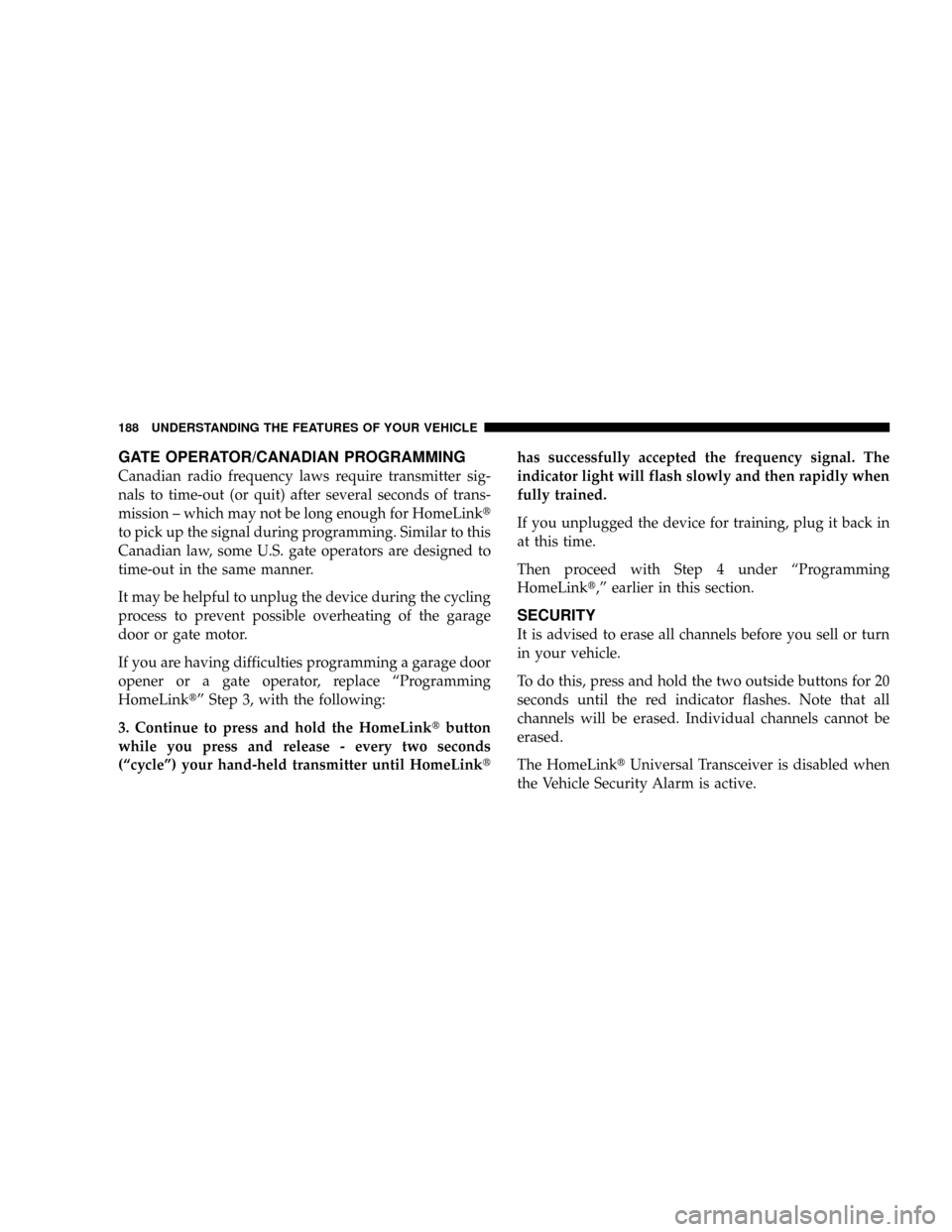
GATE OPERATOR/CANADIAN PROGRAMMING
Canadian radio frequency laws require transmitter sig-
nals to time-out (or quit) after several seconds of trans-
mission ± which may not be long enough for HomeLinkt
to pick up the signal during programming. Similar to this
Canadian law, some U.S. gate operators are designed to
time-out in the same manner.
It may be helpful to unplug the device during the cycling
process to prevent possible overheating of the garage
door or gate motor.
If you are having difficulties programming a garage door
opener or a gate operator, replace ªProgramming
HomeLinktº Step 3, with the following:
3. Continue to press and hold the HomeLinktbutton
while you press and release - every two seconds
(ªcycleº) your hand-held transmitter until HomeLinkthas successfully accepted the frequency signal. The
indicator light will flash slowly and then rapidly when
fully trained.
If you unplugged the device for training, plug it back in
at this time.
Then proceed with Step 4 under ªProgramming
HomeLinkt,º earlier in this section.
SECURITY
It is advised to erase all channels before you sell or turn
in your vehicle.
To do this, press and hold the two outside buttons for 20
seconds until the red indicator flashes. Note that all
channels will be erased. Individual channels cannot be
erased.
The HomeLinktUniversal Transceiver is disabled when
the Vehicle Security Alarm is active.
188 UNDERSTANDING THE FEATURES OF YOUR VEHICLE
Page 321 of 531
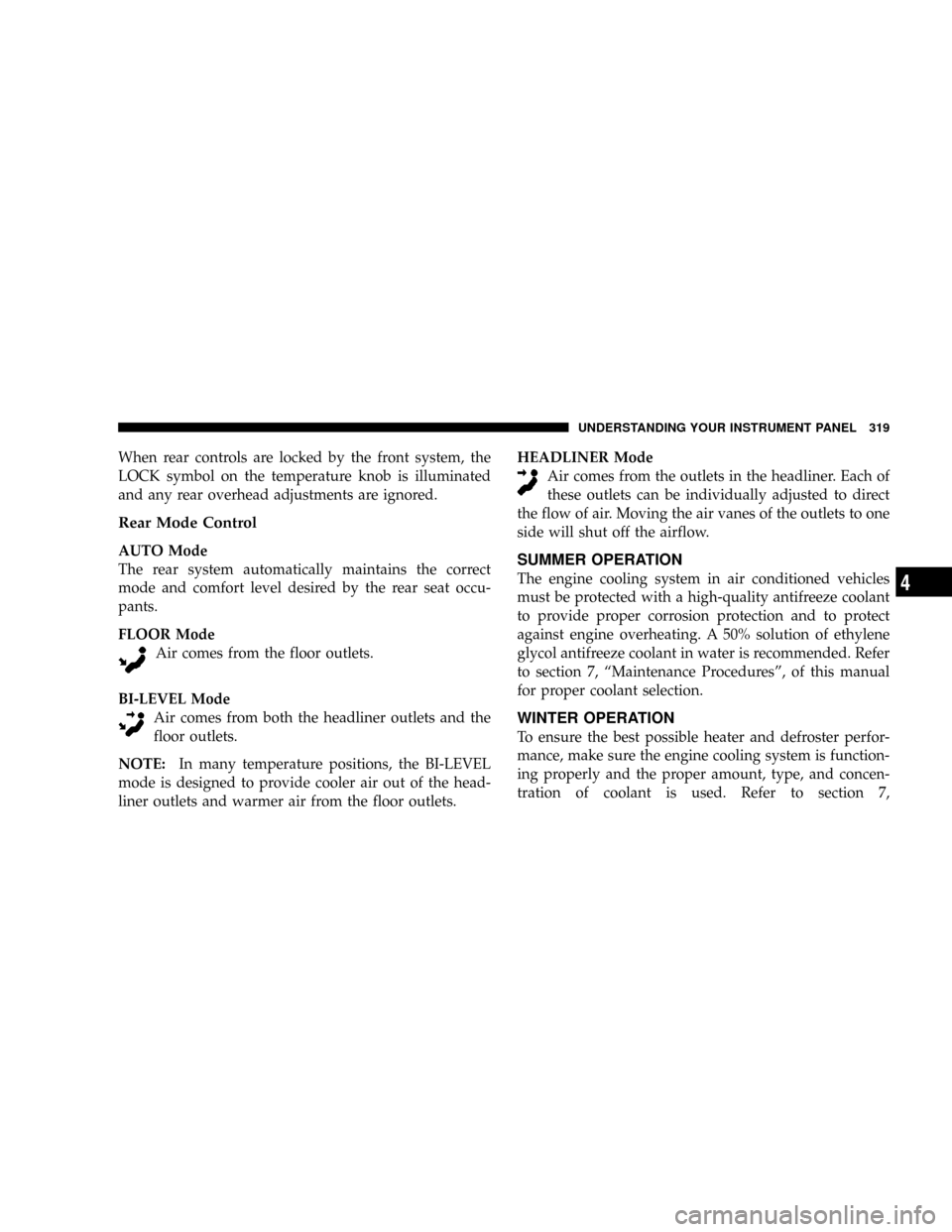
When rear controls are locked by the front system, the
LOCK symbol on the temperature knob is illuminated
and any rear overhead adjustments are ignored.
Rear Mode Control
AUTO Mode
The rear system automatically maintains the correct
mode and comfort level desired by the rear seat occu-
pants.
FLOOR Mode
Air comes from the floor outlets.
BI-LEVEL Mode
Air comes from both the headliner outlets and the
floor outlets.
NOTE:In many temperature positions, the BI-LEVEL
mode is designed to provide cooler air out of the head-
liner outlets and warmer air from the floor outlets.HEADLINER Mode
Air comes from the outlets in the headliner. Each of
these outlets can be individually adjusted to direct
the flow of air. Moving the air vanes of the outlets to one
side will shut off the airflow.SUMMER OPERATION
The engine cooling system in air conditioned vehicles
must be protected with a high-quality antifreeze coolant
to provide proper corrosion protection and to protect
against engine overheating. A 50% solution of ethylene
glycol antifreeze coolant in water is recommended. Refer
to section 7, ªMaintenance Proceduresº, of this manual
for proper coolant selection.
WINTER OPERATION
To ensure the best possible heater and defroster perfor-
mance, make sure the engine cooling system is function-
ing properly and the proper amount, type, and concen-
tration of coolant is used. Refer to section 7,
UNDERSTANDING YOUR INSTRUMENT PANEL 319
4
Page 328 of 531
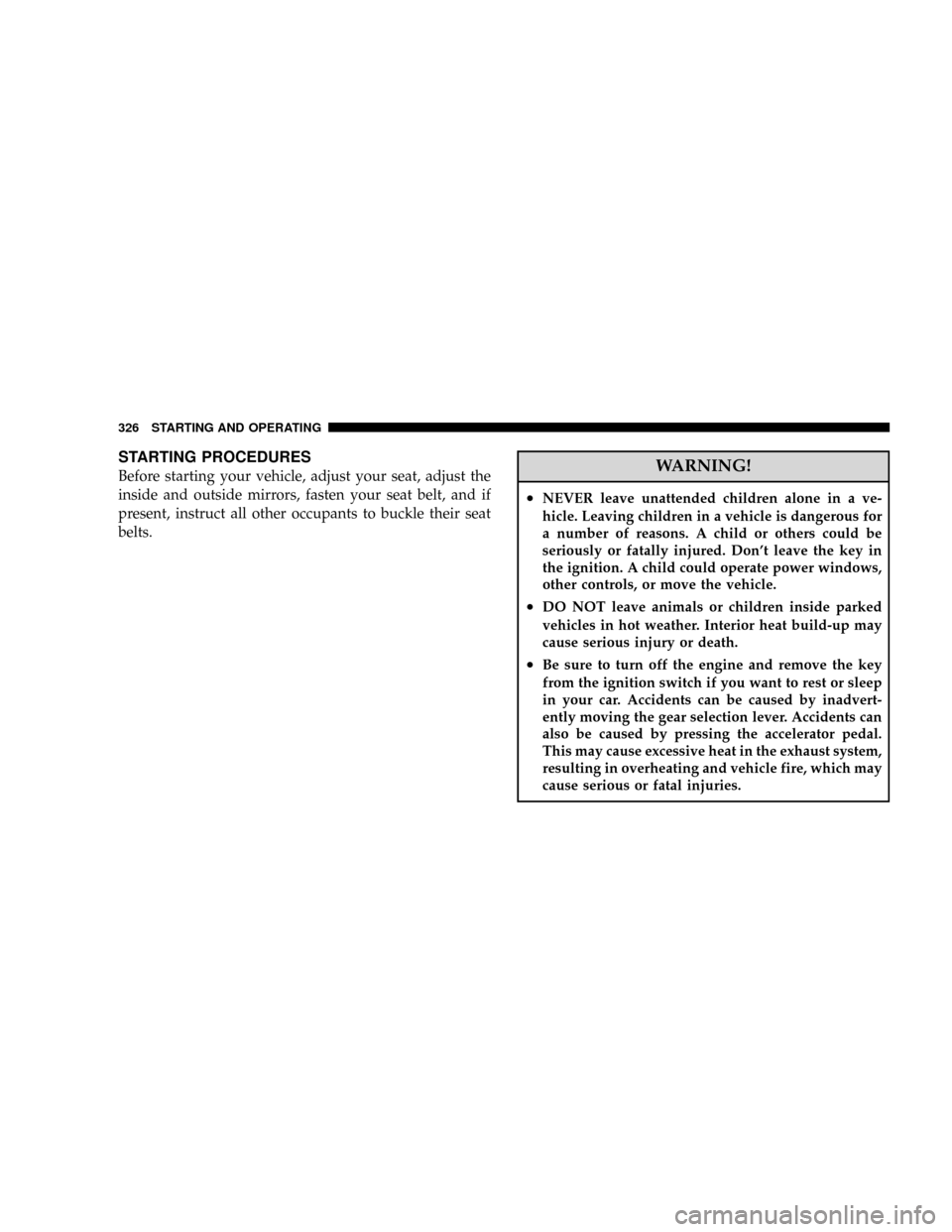
STARTING PROCEDURES
Before starting your vehicle, adjust your seat, adjust the
inside and outside mirrors, fasten your seat belt, and if
present, instruct all other occupants to buckle their seat
belts.WARNING!
²NEVER leave unattended children alone in a ve-
hicle. Leaving children in a vehicle is dangerous for
a number of reasons. A child or others could be
seriously or fatally injured. Don't leave the key in
the ignition. A child could operate power windows,
other controls, or move the vehicle.
²DO NOT leave animals or children inside parked
vehicles in hot weather. Interior heat build-up may
cause serious injury or death.
²Be sure to turn off the engine and remove the key
from the ignition switch if you want to rest or sleep
in your car. Accidents can be caused by inadvert-
ently moving the gear selection lever. Accidents can
also be caused by pressing the accelerator pedal.
This may cause excessive heat in the exhaust system,
resulting in overheating and vehicle fire, which may
cause serious or fatal injuries.
326 STARTING AND OPERATING
Page 337 of 531

using the ª5º range will improve performance and
extend transmission life by reducing excessive shifting
and heat build-up.
DRIVE Ð Four-Speed Transmission
This range should be used for most city and highway
driving. It provides the smoothest upshifts, downshifts,
and best fuel economy. However, select the ª3º range
when frequent transmission shifting occurs while using
the DRIVE range, such as when operating the vehicle
under heavy loading conditions, (i.e., in hilly terrain,
traveling into strong head winds or while towing heavy
trailers). Under these conditions, using the ª3º range will
improve performance and extend transmission life by
reducing excessive shifting and heat build-up.
CAUTION!
If the transmission operating temperature exceeds
acceptable limits, the vehicle computer will override
DRIVE and select ª5º range (on six-speed transmis-
sions) or ª3º range (on four-speed transmissions) by
changing shift points. This is done to prevent trans-
mission damage due to overheating.
Electronic Range Select (ERS) Operation
The Electronic Range Select (ERS) shift control allows
you to move the gear selector lever to the left (-) or right
(+) when the gear selector lever is in the D (Drive)
position, this allows the selection of the desired top gear.
For example, if the driver shifts the transmission into 3rd
gear, the transmission will never shift above 3rd gear, but
can shift down to 2nd or 1st gear automatically, when
needed.
STARTING AND OPERATING 335
5
Page 412 of 531
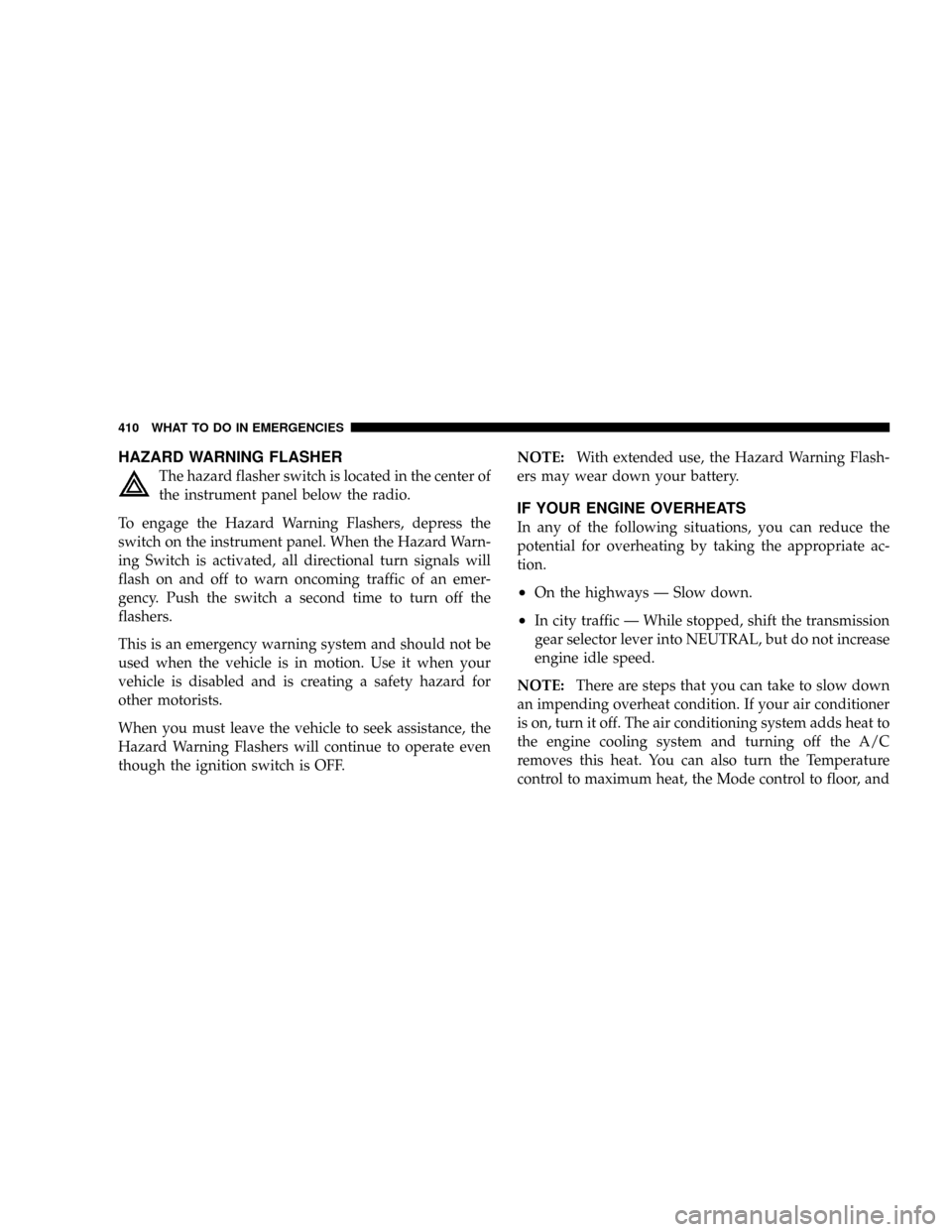
HAZARD WARNING FLASHER
The hazard flasher switch is located in the center of
the instrument panel below the radio.
To engage the Hazard Warning Flashers, depress the
switch on the instrument panel. When the Hazard Warn-
ing Switch is activated, all directional turn signals will
flash on and off to warn oncoming traffic of an emer-
gency. Push the switch a second time to turn off the
flashers.
This is an emergency warning system and should not be
used when the vehicle is in motion. Use it when your
vehicle is disabled and is creating a safety hazard for
other motorists.
When you must leave the vehicle to seek assistance, the
Hazard Warning Flashers will continue to operate even
though the ignition switch is OFF.NOTE:With extended use, the Hazard Warning Flash-
ers may wear down your battery.
IF YOUR ENGINE OVERHEATS
In any of the following situations, you can reduce the
potential for overheating by taking the appropriate ac-
tion.
²On the highways Ð Slow down.
²In city traffic Ð While stopped, shift the transmission
gear selector lever into NEUTRAL, but do not increase
engine idle speed.
NOTE:There are steps that you can take to slow down
an impending overheat condition. If your air conditioner
is on, turn it off. The air conditioning system adds heat to
the engine cooling system and turning off the A/C
removes this heat. You can also turn the Temperature
control to maximum heat, the Mode control to floor, and
410 WHAT TO DO IN EMERGENCIES
Page 429 of 531
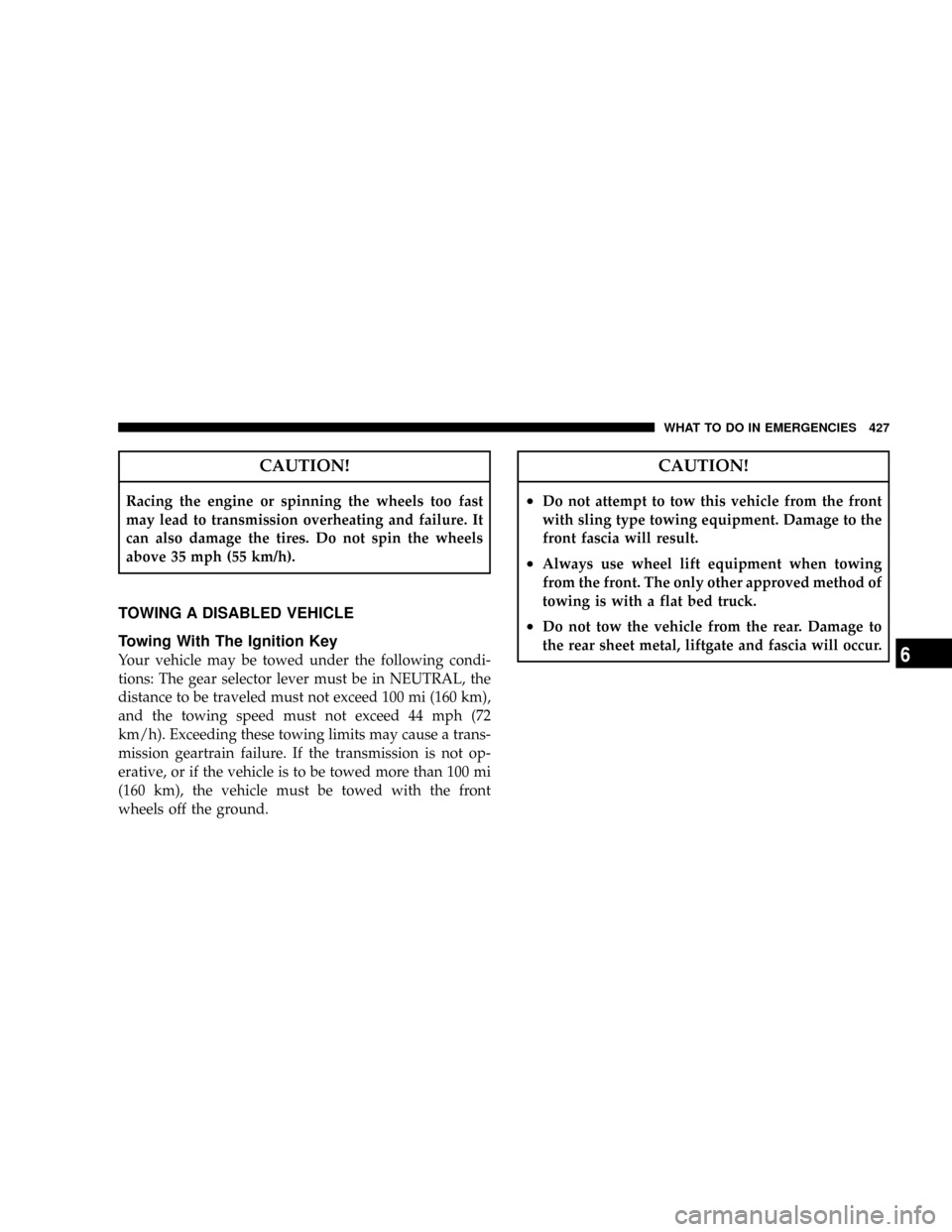
CAUTION!
Racing the engine or spinning the wheels too fast
may lead to transmission overheating and failure. It
can also damage the tires. Do not spin the wheels
above 35 mph (55 km/h).
TOWING A DISABLED VEHICLE
Towing With The Ignition Key
Your vehicle may be towed under the following condi-
tions: The gear selector lever must be in NEUTRAL, the
distance to be traveled must not exceed 100 mi (160 km),
and the towing speed must not exceed 44 mph (72
km/h). Exceeding these towing limits may cause a trans-
mission geartrain failure. If the transmission is not op-
erative, or if the vehicle is to be towed more than 100 mi
(160 km), the vehicle must be towed with the front
wheels off the ground.
CAUTION!
²Do not attempt to tow this vehicle from the front
with sling type towing equipment. Damage to the
front fascia will result.
²Always use wheel lift equipment when towing
from the front. The only other approved method of
towing is with a flat bed truck.
²Do not tow the vehicle from the rear. Damage to
the rear sheet metal, liftgate and fascia will occur.
WHAT TO DO IN EMERGENCIES 427
6
Page 447 of 531

WARNING!
A hot exhaust system can start a fire if you park over
materials that can burn. Such materials might be
grass or leaves coming into contact with your exhaust
system. Do not park or operate your vehicle in areas
where your exhaust system can contact anything that
can burn.
In unusual situations involving grossly malfunctioning
engine operation, a scorching odor may indicate severe
and abnormal catalyst overheating. If this occurs, the
vehicle should be stopped, the engine shut off and the
vehicle allowed to cool. Thereafter, service, including a
tune-up to manufacturer's specifications, should be ob-
tained immediately.To minimize the possibility of catalyst damage:²Do not shut off the engine or interrupt the ignition
when the transaxle is in gear and the vehicle is in
motion.
²Do not try to start engine by pushing or towing the
vehicle.
²Do not idle the engine with any spark plug wires
disconnected or removed, such as when diagnostic
testing, or for prolonged periods during very rough
idling or malfunctioning operating conditions.
MAINTAINING YOUR VEHICLE 445
7
Page 514 of 531
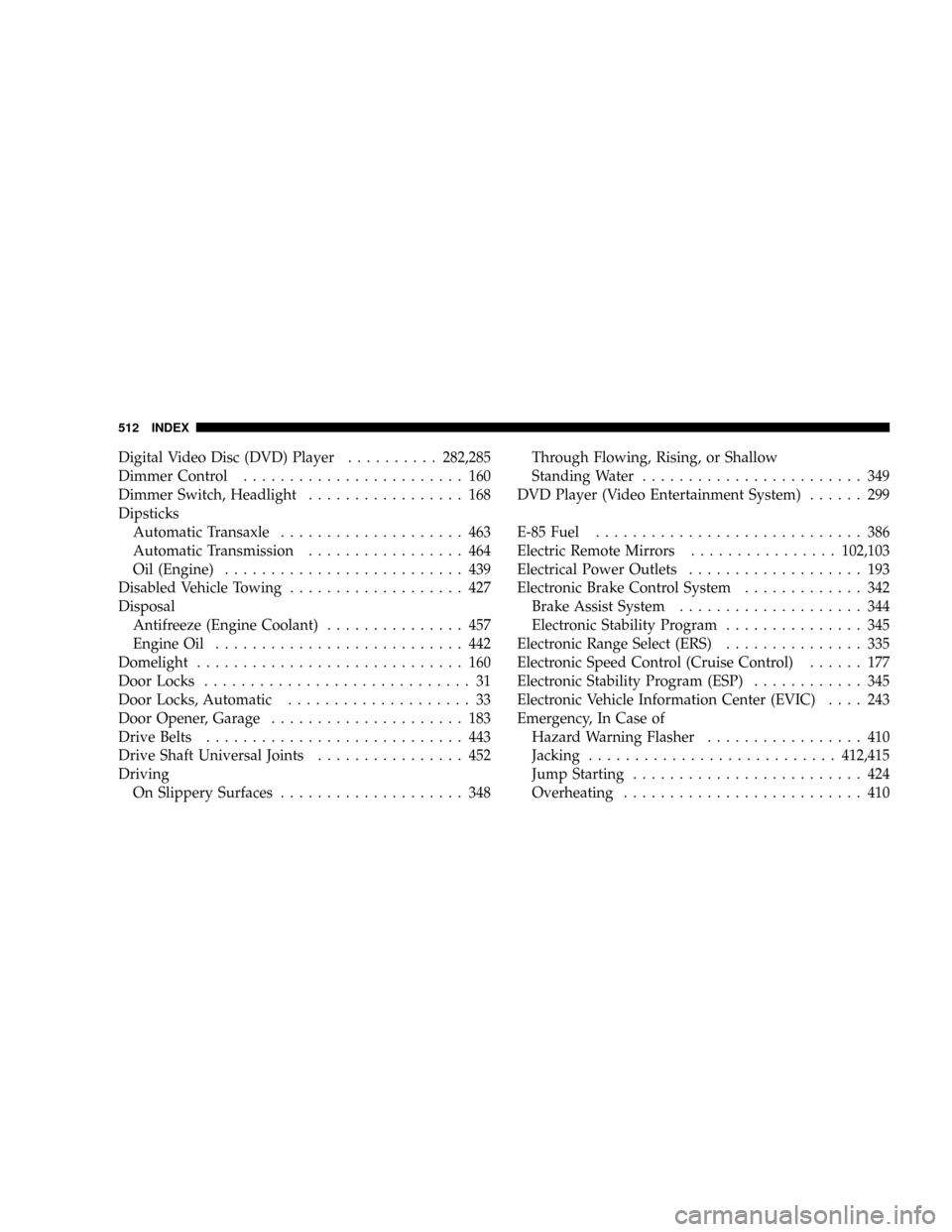
Digital Video Disc (DVD) Player..........282,285
Dimmer Control........................ 160
Dimmer Switch, Headlight................. 168
Dipsticks
Automatic Transaxle.................... 463
Automatic Transmission................. 464
Oil (Engine).......................... 439
Disabled Vehicle Towing................... 427
Disposal
Antifreeze (Engine Coolant)............... 457
Engine Oil........................... 442
Domelight............................. 160
Door Locks............................. 31
Door Locks, Automatic.................... 33
Door Opener, Garage..................... 183
Drive Belts............................ 443
Drive Shaft Universal Joints................ 452
Driving
On Slippery Surfaces.................... 348Through Flowing, Rising, or Shallow
Standing Water........................ 349
DVD Player (Video Entertainment System)...... 299
E-85 Fuel............................. 386
Electric Remote Mirrors................102,103
Electrical Power Outlets................... 193
Electronic Brake Control System............. 342
Brake Assist System.................... 344
Electronic Stability Program............... 345
Electronic Range Select (ERS)............... 335
Electronic Speed Control (Cruise Control)...... 177
Electronic Stability Program (ESP)............ 345
Electronic Vehicle Information Center (EVIC).... 243
Emergency, In Case of
Hazard Warning Flasher................. 410
Jacking...........................412,415
Jump Starting......................... 424
Overheating.......................... 410
512 INDEX